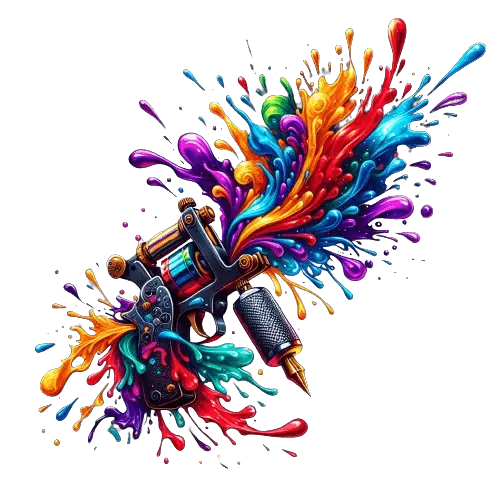Biohazard tattoos symbolize danger, risk, and a cautionary message to potential onlookers. Biohazard tattoos are unique designs that carry a significant meaning.
Often depicted as a yellow or black symbol, these tattoos represent danger, risk, and a warning sign. The biohazard symbol itself is associated with hazardous materials and infectious substances, serving as a reminder to be cautious and attentive. People who choose to get these tattoos may have a strong desire to communicate their willingness to confront dangers and take risks in their lives.
Alternatively, it could also represent resilience and the ability to overcome difficult situations. In this article, we will explore the various interpretations and cultural significance of biohazard tattoos, providing a comprehensive understanding of their meaning.
Understanding The Symbolism Of Biohazard Tattoos
Biohazard tattoos are a powerful symbol of danger and warning. These tattoos have gained popularity in recent years, attracting those who seek to embrace their edgy side and make a bold statement with their body art. Understanding the symbolism behind biohazard tattoos can shed light on the deeper meaning and significance that these symbols hold.
Origins And History Of Biohazard Tattoos
- The concept of biohazard tattoos can be traced back to the late 20th century when the biohazard symbol was adopted as a universal warning sign for hazardous substances and materials.
- Inspired by the growing fascination with danger and the desire to challenge societal norms, individuals began incorporating the biohazard symbol into their tattoo designs.
- The origins of biohazard tattoos can also be linked to the punk and alternative subcultures, where these symbols represented rebellion and non-conformity.
How Biohazard Symbols Became Associated With Tattoos
- Due to its striking appearance and recognizable symbolism, the biohazard symbol quickly became a popular choice among tattoo enthusiasts.
- Tattoo artists embraced the biohazard symbol as a way to create visually impactful designs and express their clients’ affinity for danger and risk-taking.
- The association between biohazard symbols and tattoos grew stronger over time, fueled by popular culture and the media’s portrayal of individuals with biohazard tattoos as edgy and daring.
The Meaning Behind The Biohazard Symbol In Tattoo Culture
- Biohazard tattoos often carry a meaning of caution and awareness, serving as a reminder to the wearer and those around them about the potential dangers that exist in life.
- These tattoos can symbolize resilience and the ability to overcome adversity, as individuals who choose to bear the biohazard symbol on their skin demonstrate their strength and fearlessness.
- Biohazard tattoos can also represent a desire to break free from societal norms and embrace a more unconventional way of life.
Incorporating the biohazard symbol into a tattoo design is a bold statement that carries multiple meanings. It serves as a visual reminder of danger, resilience, and rebellion. For those who choose to adorn their bodies with these symbols, biohazard tattoos become a permanent and impactful expression of their personality and outlook on life.
The Dark Allure: The Sinister Power Of Biohazard Tattoos
Biohazard tattoos have emerged as a powerful and captivating symbol in the world of body art. These tattoos hold an irresistible allure due to their dark and mysterious nature. They carry an air of danger and taboo, which is highly appealing to those who seek something outside of the mainstream.
In this blog post, we will delve into the intriguing meaning behind biohazard tattoos and explore the psychological implications they hold for their wearers. We will also examine how these tattoos serve as a means of rebellion and nonconformity, allowing individuals to express their unique identity.
So let’s unravel the sinister power of biohazard tattoos and understand why they hold such fascination for so many.
The Attraction To Dangerous And Taboo Symbolism In Tattoos:
- Biohazard tattoos embody a sense of danger and risk, attracting those who crave a thrill or wish to signify their fearlessness.
- The dark symbolism behind these tattoos acts as a magnet, drawing individuals who find beauty in the morbid and the macabre.
- The mysterious nature of biohazard tattoos intrigues people, inviting them to explore the darker aspects of their personality.
Psychological Implications Of Biohazard Tattoos:
- Biohazard tattoos can serve as a symbolic form of catharsis, allowing individuals to express and confront their fears and anxieties.
- For some, these tattoos act as a reminder of overcoming personal struggles or navigating through difficult times, representing resilience and strength.
- The act of getting a biohazard tattoo may provide a sense of control and empowerment, allowing individuals to take ownership of their bodies and experiences.
The Role Of Biohazard Tattoos In Expressing Rebellion And Nonconformity:
- By choosing a biohazard tattoo, individuals are able to challenge societal norms and embrace their nonconformist identity.
- These tattoos act as a visual statement of rebellion, pushing against the boundaries of what is considered acceptable and mainstream.
- Biohazard tattoos provide a means of differentiation, allowing wearers to stand out and assert their unique individuality.
Biohazard tattoos hold a deep and profound meaning for those who choose to adorn their bodies with this symbol. Whether it be the allure of danger, the psychological implications, or the expression of rebellion, these tattoos carry a sinister power that captivates both wearers and admirers alike.
So, embrace the darkness, and let your biohazard tattoo tell your unique story.
Unveiling The Risks And Dangers Of Biohazard Tattoos
Biohazard tattoos are a unique type of body art that carry a deeper meaning and symbolism. These tattoos often depict hazardous substances, such as biohazard symbols, warning labels, or images of dangerous chemicals or organisms. They are known for their striking and attention-grabbing appearance, but it is important to understand the risks and potential dangers associated with getting a biohazard tattoo.
Health Risks Associated With Biohazard Tattoos:
- Allergic reactions: Some individuals may have allergic reactions to the tattoo pigments or ink used in biohazard tattoos. This can lead to symptoms such as itching, redness, swelling, or even more severe reactions like anaphylaxis.
- Infections: Like any other tattoo, there is a risk of infection with biohazard tattoos. Contaminated tools, improper sterilization techniques, or unhygienic practices can introduce bacteria or viruses into the skin, leading to infections like cellulitis or hepatitis.
- Bloodborne diseases: If proper precautions are not taken during the tattooing process, there is a risk of transmitting bloodborne diseases such as hiv or hepatitis b and c. this can occur if the tattoo artist reuses needles or other equipment without proper sterilization.
Potential Complications And Infections From Improper Tattoo Procedures:
- Blowouts: Improper tattooing techniques can result in blowouts, which happen when the ink spreads beyond the intended boundaries of the tattoo. This can lead to blurred lines, smudging, or an overall distorted appearance.
- Scarring: Aggressive tattooing or improper aftercare can cause scarring, especially if the skin is irritated or fails to heal properly. Scarring can affect the aesthetic appeal of the tattoo and may require additional treatments to improve its appearance.
- Infections: If the tattoo artist does not follow proper sterilization practices or if the individual fails to care for their tattoo during the healing process, infections can occur. Common signs of infection include increased pain, redness, swelling, pus, or an unpleasant odor.
The Importance Of Proper Aftercare For Biohazard Tattoos:
- Clean and moisturize: Following the tattooing process, it is crucial to keep the tattooed area clean and moisturized. This helps prevent infections and promotes proper healing. Use mild, fragrance-free soaps and moisturizers recommended by the tattoo artist.
- Avoid exposure to contaminants: During the healing process, it is important to avoid exposing the tattoo to contaminants such as dirty water, excessive sweat, or direct sunlight. These can increase the risk of infection or compromise the quality of the tattoo.
- Follow the aftercare instructions: Every tattoo artist may have their own set of aftercare instructions. It is essential to adhere to these instructions carefully, including avoiding scratching or picking at the tattoo, avoiding tight clothing that rubs against the tattoo, and keeping the area dry during the healing process.
While biohazard tattoos can be visually striking and meaningful, it is important to be aware of the risks and dangers associated with them. By understanding the health risks, potential complications, and the importance of proper aftercare, individuals can make informed decisions and reduce the chances of experiencing any adverse effects.
Remember to choose a reputable tattoo artist who follows proper hygiene practices and always prioritize your health and safety when getting any type of tattoo.
Breaking The Stigma: Diverse Interpretations Of Biohazard Tattoos
Biohazard tattoos have long been associated with danger, warning signs, and the potential for harm. However, these tattoos hold a deeper meaning for individuals who choose to get them inked on their bodies. Breaking free from the confines of traditional interpretations, people have found alternative ways to personalize this symbol to represent their own experiences.
Understanding the non-sinister motivations behind getting a biohazard tattoo sheds light on the true depth and complexity associated with this powerful emblem.
Alternative Interpretations And Meanings Of Biohazard Tattoos:
- Symbol of resilience: For some, a biohazard tattoo serves as a reminder of their ability to overcome challenging circumstances and emerge stronger.
- Representation of transformation: The biohazard symbol can signify a personal transformation or a specific period of growth in one’s life.
- Conveyance of self-protection: In a world filled with uncertainties, a biohazard tattoo can represent a person’s desire to protect themselves, physically or emotionally.
- Sign of survival: Individuals who have experienced life-threatening illnesses or accidents may choose a biohazard tattoo as a symbolic representation of their survival and resilience.
How Individuals Personalize The Symbol To Represent Their Own Experiences:
- Incorporating personal elements: Many individuals customize their biohazard tattoos by adding personal elements such as flowers, animals, or meaningful symbols to make it uniquely their own.
- Using color symbolism: Color plays a significant role in personalizing the biohazard tattoo. Individuals often choose colors that hold personal significance or represent different emotions, further adding depth to the symbol.
- Incorporating text: Including meaningful quotes, dates, or names alongside the biohazard symbol allows individuals to fully personalize their tattoo and create a more narrative representation of their experiences.
Non-Sinister Motivations Behind Getting A Biohazard Tattoo:
- Empowerment and self-expression: People often get biohazard tattoos as a form of self-expression, embracing their unique perspective and desire to stand out from the crowd.
- Honoring a profession: Biohazard tattoos can be a way for individuals in certain professions, like healthcare workers or scientists, to pay homage to their work and the impact they make in their field.
- Showing solidarity: Some individuals choose to get biohazard tattoos to show support for causes related to public health, environmental conservation, or other issues they feel passionate about.
Biohazard tattoos are a powerful symbol that can carry various interpretations and meanings. Ditching the notion of stereotypical danger, people have imbued these tattoos with personal significance, transforming them into unique symbols that represent their own experiences, resilience, and personal growth.
By understanding the motivations and symbolism behind these tattoos, we can break the stigma and appreciate the diverse interpretations that exist within the world of biohazard ink.
The Artistry And Aesthetics Of Biohazard Tattoos
Biohazard tattoos are unique and visually striking designs that incorporate the universal symbol for biohazards. These tattoos hold deep meanings and can be visually captivating, making them a popular choice for those seeking to express their individuality and love for the unconventional.
In this blog post section, we will explore the artistry and aesthetics of biohazard tattoos, delving into the creative designs that incorporate the symbol, the unique styles and techniques used in creating them, as well as the role of color, shading, and placement in enhancing their impact.
Creative Designs Incorporating The Biohazard Symbol
- Combination with meaningful elements: Biohazard symbols can be seamlessly integrated into various tattoo designs like skulls, flowers, or even animals, adding depth and symbolism to the artwork.
- Abstract interpretations: Some tattoo artists opt for a more abstract approach, playing with shapes, lines, and textures to create visually intriguing biohazard tattoos that captivate the viewer’s attention.
- Incorporating text: Immortalizing words or phrases alongside the biohazard symbol can provide additional context and meaning to the tattoo, making it even more personal and thought-provoking.
Unique Styles And Techniques Used In Creating Biohazard Tattoos
- Watercolor technique: This style involves using vibrant splashes of color and delicate washes to create a dreamy, ethereal effect. Watercolor biohazard tattoos can display a sense of fluidity and movement, elevating the design to a whole new level.
- Geometric precision: Utilizing sharp lines, clean shapes, and precise angles, geometric biohazard tattoos offer a contemporary and minimalist take on the symbol. The result is a visually striking design that stands out for its simplicity and symmetry.
- Dotwork: By utilizing tiny dots to create intricate patterns and shading, dotwork biohazard tattoos offer a unique and mesmerizing artwork. This technique is time-consuming but results in a high level of detail and texture, adding depth and dimension to the tattoo.
The Role Of Color, Shading, And Placement In Enhancing The Impact Of Biohazard Tattoos
- Vibrant colors: Choosing bold and striking colors can make the biohazard symbol pop, creating an eye-catching contrast that draws attention to the tattoo.
- Effective shading: Skillful shading techniques can transform a biohazard tattoo from a flat symbol to a three-dimensional masterpiece, adding depth and realism to the design.
- Thoughtful placement: The location of a biohazard tattoo can greatly impact its overall effect. Placing it on prominent areas like the forearm or chest can showcase the design to the world, while more hidden locations like the upper back or ribcage can add an element of mystery and intrigue.
Biohazard tattoos are not only about the symbol itself, but also about the creativity and skill of the artist in bringing the design to life. The artistry and aesthetics of biohazard tattoos allow individuals to express their innermost thoughts, emotions, and experiences in a visually captivating and meaningful way.
So, whether you’re considering getting a biohazard tattoo or simply appreciating their beauty, these tattoos are undeniably a unique form of body art that continues to fascinate and inspire.
Biohazard Tattoos In Popular Culture: Hollywood’S Take On The Sinister Symbol
Biohazard tattoos have long captivated our imagination, symbolizing danger, mystery, and a sinister allure. In popular culture, hollywood has taken this symbol and woven it into stories that both fascinate and terrify us. From movies to tv shows, the portrayal of biohazard tattoos has left an indelible mark on our collective consciousness.
In this section, we will explore how biohazard tattoos are depicted in popular culture and the impact that media has had on shaping our perception of these enigmatic symbols.
Depictions Of Biohazard Tattoos In Movies And Tv Shows:
- Movies and tv shows frequently incorporate biohazard tattoos as a visual representation of danger and foreboding.
- These tattoos are often sported by characters associated with criminal or apocalyptic narratives.
- Directors and costumers use biohazard tattoos to enhance a character’s sense of rebellion, edginess, and mysterious past.
How Popular Culture Portrays The Sinister Power Of Biohazard Tattoos:
- Biohazard tattoos are commonly used to depict characters who possess special abilities, supernatural powers, or post-apocalyptic survival skills.
- The tattoos mark these characters as unique, dangerous, or tainted in some way.
- The dark allure of biohazard tattoos serves to captivate the audience’s curiosity and adds an element of intrigue to the character’s persona.
The Influence Of Media On The Perception Of Biohazard Tattoos:
- Biohazard tattoos in movies and tv shows have contributed to a broader fascination with the symbolism and meaning behind them.
- Media exposure has sparked a desire among some individuals to get their own biohazard tattoos as a form of self-expression or to convey their affinity for danger and rebellion.
- However, it is crucial to remember that the meaning behind biohazard tattoos is not limited to their portrayal in popular culture. Each person may have their own personal interpretation or reason for getting such a tattoo.
Through the lens of popular culture, biohazard tattoos have been imbued with an aura of danger, mystery, and power. Their presence in movies and tv shows has played a significant role in shaping our perception of these enigmatic symbols. Whether they are used to depict characters with supernatural abilities or as a visual representation of rebellion, biohazard tattoos continue to spark our imagination and provoke curiosity.
Biohazard Tattoos And The Marginalized: Symbolism In Subcultures
Biohazard tattoos have long been associated with symbolism in subcultures, particularly within marginalized communities. These tattoos hold great significance for individuals who identify with specific subcultures, serving as a powerful representation of their beliefs, values, and sense of camaraderie. Let’s explore the connection between biohazard tattoos and these subcultures, the importance of these tattoos within marginalized communities, and how they play a role in building camaraderie and identity.
Connection Between Biohazard Tattoos And Specific Subcultures:
- Biohazard tattoos are commonly seen within subcultures such as punk, goth, metal, and underground music scenes.
- These tattoos represent an individual’s rebellion against societal norms and a rejection of mainstream culture.
- Within these subcultures, biohazard tattoos are often worn as a form of protest or a statement against conformity.
- They serve as a visual symbol of the subculture’s values, ideologies, and shared identity.
- Biohazard tattoos can also signify a commitment to the subculture’s lifestyle and principles, demonstrating a sense of dedication and belonging.
The Significance Of Biohazard Tattoos Within Marginalized Communities:
- Marginalized communities often face societal discrimination and stigmatization, leading them to form tight-knit communities for support and empowerment.
- Biohazard tattoos hold significant meaning within these communities, acting as a visual representation of resilience and strength.
- These tattoos can serve as a badge of honor, symbolizing a shared experience of adversity and survival.
- Biohazard tattoos within marginalized communities often convey messages of defiance, resilience, and the refusal to be silenced or marginalized further.
The Role Of Biohazard Tattoos In Building Camaraderie And Identity Within Subcultures:
- Biohazard tattoos not only establish a sense of camaraderie among individuals who share similar values and interests but also create a visual marker for others within the subculture to recognize and connect with one another.
- These tattoos help forge a sense of identity and belonging, providing a visual representation of an individual’s affiliation with a specific subculture.
- Biohazard tattoos can spark conversations and interactions, fostering a sense of community and a shared journey.
- By displaying their biohazard tattoos, individuals within subcultures can find acceptance, understanding, and a sense of kinship with others who have made similar choices.
Biohazard tattoos hold profound meaning within subcultures, especially within marginalized communities. These tattoos not only connect individuals to their shared beliefs and values but also play a crucial role in building camaraderie and identity. They empower individuals to assert their independence and find strength in their uniqueness.
The Controversy Surrounding Biohazard Tattoos: Legal And Ethical Considerations
Biohazard tattoos have become increasingly popular in recent years due to their striking visual appeal and symbolic meaning. However, the use of biohazard symbols in tattoos raises both legal and ethical concerns that cannot be ignored. Tattoo enthusiasts, artists, and society as a whole must consider the implications of choosing and displaying these tattoos responsibly.
In this section, we will delve into the controversy surrounding biohazard tattoos, focusing on the legal and ethical considerations at play.
Legal Implications Of Biohazard Tattoos In Different Jurisdictions:
- The use of certain symbols, including biohazard symbols, may be protected under copyright laws in some jurisdictions. Tattoo artists and clients must be aware of any potential legal issues before proceeding with a biohazard tattoo.
- Some countries have specific regulations governing the display of biohazard symbols. For instance, in certain european countries, biohazard symbols are associated with hazardous waste and are governed by strict regulations. Tattoo artists should educate themselves on these regulations to ensure compliance.
- In some cases, biohazard symbols may be associated with illegal activities, such as the production of dangerous substances. Tattoo artists and clients should be cautious about displaying such symbols to avoid any association with illegal behavior.
Ethical Debates Surrounding The Use Of Biohazard Symbols In Tattoos:
- The biohazard symbol is universally recognized as a warning sign for potential hazards. Some argue that using this symbol in tattoos may trivialize its meaning and diminish its impact in actual hazardous situations.
- Biohazard tattoos can be seen as insensitive or offensive to those who have been directly affected by real-life biohazard incidents or have lost loved ones due to such situations. Tattoo artists and clients should be sensitive to these concerns and consider the potential impact of their choices.
- There is ongoing debate about whether biohazard symbols should be reserved for professionals and organizations directly involved in dealing with hazardous materials, rather than being used for aesthetic purposes.
The Responsibility Of Tattoo Artists And Clients In Choosing And Displaying Biohazard Tattoos:
- Tattoo artists have a responsibility to inform their clients about the potential legal and ethical implications of getting a biohazard tattoo. They should also ensure that clients understand the meaning and symbolism behind the biohazard symbol.
- Clients should conduct thorough research and consider the potential consequences before deciding to get a biohazard tattoo. They should be mindful of the message they may be sending and the impact it could have on others.
- Open communication between tattoo artists and clients is crucial to ensure informed decision-making and responsible tattooing.
Biohazard tattoos may be visually captivating, but they come with legal and ethical considerations that cannot be ignored. Understanding the legal implications, ethical debates, and the responsibility of tattoo artists and clients is essential in making informed choices and promoting responsible tattooing practices.
Frequently Asked Questions Of Biohazard Tattoo Meaning
What Is The Meaning Of A Biohazard Tattoo?
A biohazard tattoo symbolizes danger, warning others about potentially harmful substances or situations.
What Does A Biohazard Tattoo Represent?
A biohazard tattoo represents a person’s interest in hazardous materials or their commitment to staying safe in dangerous environments.
Are There Different Variations Of Biohazard Tattoos?
Yes, there are various designs of biohazard tattoos including skulls, symbols, or creative artistic representations of biohazard warnings.
Conclusion
To wrap up, the biohazard tattoo carries a significant meaning that goes beyond its bold and striking appearance. It serves as a powerful symbol of resilience, strength, and the ability to overcome adversity. By embracing the biohazard tattoo, individuals can communicate their own personal struggles and triumphs, reminding themselves and others of their inherent ability to handle any challenges that come their way.
Whether it signifies a battle with illness, addiction, or other hardships, this tattoo serves as a constant reminder of one’s mental and emotional resilience. With its powerful symbolism and striking design, the biohazard tattoo is a choice that can truly inspire and empower individuals to face life’s difficulties head-on.
So, if you are looking to showcase your inner strength and determination, don’t be afraid to consider the biohazard tattoo as an emblem of your journey towards overcoming obstacles and emerging stronger than ever before.




